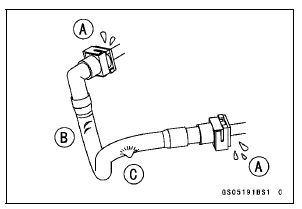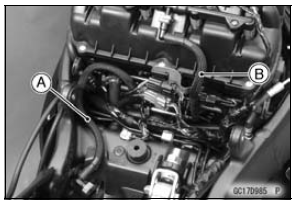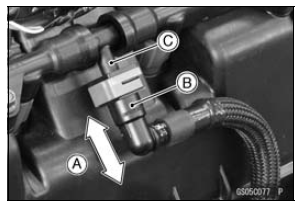

Replace the fuel hose if any fraying, cracks [B] or bulges [C] are noticed.

Replace the hose if it has been sharply bent or kinked.

Push and pull [A] the fuel hose joint [B] back and forth more than two times, and make sure it is locked.
Check the other hose joint in the same way.

NOTICE
When pushing and pulling the fuel hose joint, do not apply strong force to the delivery pipe [C] on the nozzle assy. The pipe made from resin could be damaged.
| WARNING Leaking fuel can cause a fire or explosion resulting in serious burns. Make sure the hose joint is installed correctly on the delivery pipe by sliding the joint. |
If it does not locked, reinstall the hose joint.
 Idle Speed Inspection
Idle Speed Inspection Evaporative Emission Control System Inspection (CAL and SEA-B1 Models)
Evaporative Emission Control System Inspection (CAL and SEA-B1 Models)Engine Oil
In order for the engine, transmission,
and clutch to function properly, maintain
the engine oil at the proper level,
and change the oil and replace the oil
filter in accordance with the Periodic
Maintenance Chart. Not only do dirt
and metal particles collect in the oil, but
the oil itself los ...
Water Temperature Sensor Resistance Inspection
Refer to the Water Temperature Sensor Inspection in the
Electrical System chapter.
If the reading is within the standard, but the problem still
exists, replace the ECU (see ECU Removal/Installation in
the Fuel System (DFI) chapter).
Water Temperature Sensor Circuit
1. ECU
2. Water T ...
Meter Unit Inspection
Remove the meter unit (see Meter Unit Removal).
[1] Battery (+)
[2] Fuel Reserve Switch
[3] Ground (–)
[4] Unused
[5] Right Turn Signal Indicator Light (LED) (+)
[6] Left Turn Signal Indicator Light (LED) (+)
[7] High Beam Indicator Light (LED) (+)
[8] Neutral Indicator Light (LED) (в ...